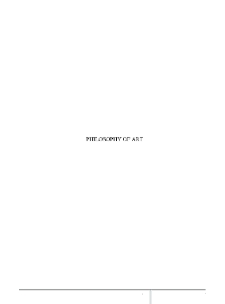Նիւթ
Վերնագիր: Raphael's “The School of Athens”: A Hypothesis on the Identity and Symbolic Meaning of the Figure in White Cloak: The True Muse of Raphael
Ամսագրի կամ հրապարակման վերնագիր:
Հրապարակման ամսաթիւ:
Հատոր:
Համար:
ISSN:
Համատեղ հեղինակները:
Խ․ Աբովյանի անվան հայկական պետական մանկավարժական համալսարան
Ծածկոյթ:
Ամփոփում:
Raphael's fresco “The School of Athens” is rich withfigures of prominent philosophers who are identified by their certain characteristic details. The identity of a figure in Raphael's “The School of Athens” Plato group traditionally attributed to Francesco Rovere, is currently being questioned. Present article brings forward a new hypothesis on this matter: the aforementioned figure is seen as a collective figure that symbolizes the unity of a man and a woman, in this case, Raphael and his muse. Besides, this figure also encodes the year when the fresco waspainted. As a key to the code, the blackboard containing the Platonic perfect number 10 immediately at the figure‟s feet is important, as well as the positions of some of the figures in the first row on the left part of the painting. The article also makes some revelations about Raphael's real muse, who, according to the author, was the courtesan Imperia. Evidence of this is the fact that Imperia is portrayed in many of Raphael's works.
Հրատարակութեան վայրը:
Երևան
Հրատարակիչ:
Ձեւաչափ:
Նոյնացուցիչ:
oai:arar.sci.am:372368
Լեզու:
Նիւթին հաւաքածոները:
Վերջին անգամ ձեւափոխուած է:
Oct 8, 2025
Մեր գրադարանին մէջ է սկսեալ:
Apr 4, 2024
Նիւթին բովանդակութեան հարուածներուն քանակը:
58
Նիւթին բոլոր հասանելի տարբերակները:
https://arar.sci.am/publication/402272
Ցոյց տուր նկարագրութիւնը RDF ձեւաչափով:
Ցոյց տուր նկարագրութիւնը OAI-PMH ձեւաչափով։
-
Իմաստություն=Wisdom=Мудрость
-
Իմաստություն, 2013, N 1
-
Իմաստություն, 2014, N 1 (2)
-
Իմաստություն, 2014, N 2 (3)
-
Իմաստություն, 2015, N 1 (4)
-
Wisdom, 2015, N 2 (5)
-
Wisdom, 2016, N 1 (6)
-
Wisdom, 2016, N 2 (7)
-
Wisdom, 2017, N 1 (8)
-
Wisdom, 2017, N 2 (9)
-
Wisdom, 2018, N 1 (10)
-
Wisdom, 2018, N 2 (11)
-
Wisdom, 2019, N 1 (12)
-
Wisdom, 2019, N 2 (13)
-
Wisdom, 2020, N 1 (14)
-
Wisdom, 2020, N 2 (15)
-
Wisdom, 2020, N 3 (16)
-
Wisdom, 2021, N 1 (17)
-
Wisdom, 2021, N 1 (1) Special issue
-
Wisdom, 2021, N 2 (18)
-
Wisdom, 2021, N 3 (19)
-
Wisdom, 2021, N 4 (20)
-
Wisdom, 2022, N 1 (21)
-
Wisdom, 2022, N 1 (2) Special issue
-
Wisdom, 2022, N 2 (22)
-
Wisdom, 2022, N 2 (3) Special issue
-
Wisdom, 2022, N 3 (23)
-
Wisdom, 2022, N 3 (4) Special issue
-
Wisdom, 2022, N 4 (24)
-
Wisdom, 2023, N 1 (25)
-
Wisdom, 2023, N 2 (26)
- Editorial board
- Contents
- Editor`s Foreword
- An Аxiomatic System of Philosophical Ontology
- The Problem of the Subject and Object of Cognition in Postnonclassical Science
- Coalitions as a Factor in the Institutionalization of the Transition to Democracy
- The Denotation of Socio-Political Infantilism in the Context of RA Democratization
- Vocation: Theory and Practice
- Psychological Study of the Environmental Factors of Personal Creativity Manifestation
- Concept of Public Administration in the Context of Globalization
- Formation of Thought Style in Organizing the Educational Process and Training of Medical Students
- Pedagogical Potential of the Philosophy of Atheistic Existentialism and Humanistic Psychoanalysis
- Evaluation Model for Virtue Education in Business English Courses
- Islamic Nomocracy: Muhammadiyah‟s Philosophy on the Relationship Between Religion and the State in Indonesia
- Liberalism and Religious Moderation: The Dilemma in Indonesia
- Raphael's “The School of Athens”: A Hypothesis on the Identity and Symbolic Meaning of the Figure in White Cloak: The True Muse of Raphael
- The Associative Characteristics of Linguophilosophical Concept “Freedom” in English, Armenian and Chinese Linguocultures
- The Basic Principles of Perception of Phenomena in Eastern and Western Folklore
- A Linguistic-Pragmatic Study on Collocations in Business Media Discourse
- Syntactic Stylistic Devices of Speech Manipulation in the English-Language Lifestyle Media Discourse
- Human Rights and Freedoms: Ensuring a Balance of Public Interests
- Methodological Foundations of Socio-Philosophical and Legal Analysis of Corruption
- The Liability of Corporate Governance Bodies as a Philosophical-Legal Category
- The Impact of Behaviorist Theories and the Legal System Laws Developed from Them
- The Philosophical Thought of the Prophetic Law in the Indonesian Legal System
- Сoncept of Alienation in the Works of K. Marx and J. Baudrillard
- Notes to Contributors
-
Wisdom, 2023, N 3 (27)
-
Wisdom, 2023, N 4 (28)
-
Wisdom, 2024, N 1 (29)
-
Wisdom, 2024, N 2 (30)
-
Իմաստություն, 2013, N 1
| Հրատարակութեան անունը | Թուական |
|---|---|
| Bezirganyan, Vahan, Raphael's “The School of Athens”: A Hypothesis on the Identity and Symbolic Meaning of the Figure in White Cloak: The True Muse of Raphael | Oct 8, 2025 |





